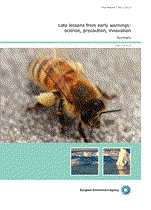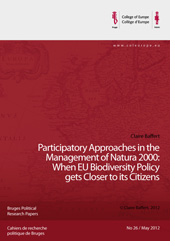News
SPIRAL "UK National Ecosystem Assessment" paper publshed
A new paper has been published based on work carried for SPIRAL, authored by Kerry Waylen and Juliette Young. This paper focuses on the first phase of the UK National Ecosystem Assessment.
Upcoming Event
No upcoming events.
News
Late lessons from early warnings: science, precaution, innovation
Wed, 01/30/2013 - 13:36 — Koen Van Muylem The 2013 Late lessons from early warnings report is the second of its type produced by the European Environment Agency (EEA) in collaboration with a broad range of external authors and peer reviewers.
The 2013 Late lessons from early warnings report is the second of its type produced by the European Environment Agency (EEA) in collaboration with a broad range of external authors and peer reviewers.
The case studies across both volumes of Late lessons from early warnings cover a diverse range of chemical and technological innovations, and highlight a number of systemic problems.
IPBES-1 Side Event: BiodiversityKnowledge, SPIRAL and GEOBON
Mon, 01/28/2013 - 13:47 — Koen Van MuylemOn Friday January 25th 2013, FP7 projects BiodiversityKnowldege, SPIRAL and EBONE organized an IPBES side event where they gave information about the existing regional support approaches to IPBES-Europe.
We have attached the presentations that were shown. Please contact us if you need more information.
Improving Interfaces between EU research projects and EU policy-making
Mon, 10/29/2012 - 11:11 — Koen Van Muylem A number of recommendations have been developed in the context of a SPIRAL- DG Research workshop on “Better interfacing EU research projects and EU policy-making”, with the participation of the European Environmental Agency (EEA). The workshop brought together coordinators and other representatives of EU-funded biodiversity research projects and science-policy experts, including representatives from the European Commission Directorate General for Environment (DG ENV). Together participants brought experience from more than 50 projects funded under the current and past framework programmes for research. The recommendations build on the workshop discussions and on the research carried out in SPIRAL. They address strategic as well as operational aspects of science-policy interfaces. They also critically explore the potential contributions of the Biodiversity Information System for Europe (BISE) and Eye on Earth (EoE) to science-policy interaction processes.
A number of recommendations have been developed in the context of a SPIRAL- DG Research workshop on “Better interfacing EU research projects and EU policy-making”, with the participation of the European Environmental Agency (EEA). The workshop brought together coordinators and other representatives of EU-funded biodiversity research projects and science-policy experts, including representatives from the European Commission Directorate General for Environment (DG ENV). Together participants brought experience from more than 50 projects funded under the current and past framework programmes for research. The recommendations build on the workshop discussions and on the research carried out in SPIRAL. They address strategic as well as operational aspects of science-policy interfaces. They also critically explore the potential contributions of the Biodiversity Information System for Europe (BISE) and Eye on Earth (EoE) to science-policy interaction processes.
Science and policy united to tackle eutrophication in Mediterranean
Sun, 10/14/2012 - 14:25 — Koen Van MuylemTogether, European policy and research initiatives provide a sound basis for actions to tackle eutrophication in the Mediterranean Sea, a recent analysis concludes. The review brings together scientific understanding from over 50 years of research on eutrophication and a discussion of the policy frameworks currently in place to deal with this issue.
 High levels of certain nutrients in rivers, lakes and marine environments lead to surface blooms of phytoplankton - microscopic plants which consume oxygen and block out light from deeper layers. This leads to a scenario known as eutrophication.
High levels of certain nutrients in rivers, lakes and marine environments lead to surface blooms of phytoplankton - microscopic plants which consume oxygen and block out light from deeper layers. This leads to a scenario known as eutrophication.
Mixed success for European environmental policies
Mon, 07/23/2012 - 17:34 — Koen Van Muylem European environmental policies have enabled some progress towards a sustainable green economy, according to a recent report from the European Environment Agency. The report identifies the progress made against a suite of environmental indicators set by the European Environment Agency which show that policies to encourage resource efficiency have been moderately successful. However, policies designed to improve ecosystem resilience have met with less success, potentially due to the longer timescales required to see progress in this area. The report concludes that Europe needs new policies and objectives that recognise the links between resource efficiency and ecosystem resilience if it is to move to a sustainable green economy.
European environmental policies have enabled some progress towards a sustainable green economy, according to a recent report from the European Environment Agency. The report identifies the progress made against a suite of environmental indicators set by the European Environment Agency which show that policies to encourage resource efficiency have been moderately successful. However, policies designed to improve ecosystem resilience have met with less success, potentially due to the longer timescales required to see progress in this area. The report concludes that Europe needs new policies and objectives that recognise the links between resource efficiency and ecosystem resilience if it is to move to a sustainable green economy.
 The EU is seeking to transition to a green economy: that is, an economy in which environmental, economic and social policies and innovation enable society to use resources efficiently, while mainta
The EU is seeking to transition to a green economy: that is, an economy in which environmental, economic and social policies and innovation enable society to use resources efficiently, while mainta
Getting the message across; Biodiversity Science and Policy Interfaces - A Review
Thu, 07/12/2012 - 16:02 — Koen Van MuylemDr. Marjan Spierenburg analyses the difficulties of biodiversity policy making: biodiversity scientists should confront the political aspects of decision-making relating to biodiversity. Policy-relevant research entails careful assessment of social-ecological systems and possible trade-offs, taking into account the diversity of perspectives of the various stakeholders, being explicit about underlying framings and various policy options, and developing reflexive governance approaches.
This contribution analyses the difficulties of biodiversity policy-making and the role of science. It addresses biodiversity scientists' struggles to communicate the value of biodiversity to policy-makers, and the tensions between producing policyrelevant research and being perceived as too prescriptive.
Intergovernmental Platform on Biodiversity and Ecosystem Services (IPBES) - Reconnecting science to policy: Why? What? How?
Wed, 07/04/2012 - 09:37 — Koen Van MuylemA report on the brieffing session "Intergovernmental Platform on Biodiversity and Ecosystem Services (IPBES) - Reconnecting science to policy: Why? What? How?" that took place in the European Parliament in June 2012 is now available for download.
You can choose between the short version in either French or English or the full version in English.
Habitat mapping method could help restore biodiversity
Tue, 07/03/2012 - 11:05 — Koen Van MuylemA new method for mapping long-term changes in habitat over large areas and in fine detail has been developed, which could help inform conservation plans to restore biodiversity to previous states. In a UK case study, researchers have used it to demonstrate the dramatic effects of intensive agriculture and afforestation on rural habitats since the 1930s.
Driven by increased demand for food and growing populations, major changes in rural landscapes during the second half of the 20th century, particularly in Western Europe, have had damaging effects on biodiversity.
Participatory Approaches in the Management of Natura 2000: When EU Biodiversity Policy gets Closer to its Citizens
Wed, 06/20/2012 - 08:08 — Koen Van Muylem Claire Baffert published a "Bruges Political Research Paper" on participatory approaches in the mnagement of Natura 2000.
Claire Baffert published a "Bruges Political Research Paper" on participatory approaches in the mnagement of Natura 2000.
Main findings are that participation was mostly implemented as a reaction to conflicts and out of a concern over policy implementation, two elements that continue to drive the philosophy of the Natura 2000 network‘s management. The limits of participation in Brussels are contrasted with the potential for more genuine and effective participation mechanisms on the field.
Consultation on the EU environment policy priorities for 2020
Sun, 03/18/2012 - 14:14 — Koen Van MuylemEnvironment Action Programmes have guided the development of EU environment policy since the early seventies. During this period, environment legislation was consolidated and completed to cover almost all environmental media, with the exception of soil. With the 6th EAP in its final year, the Commission continues to pursue an ambitious environment policy aimed at ensuring a high level of environmental protection and guided by the principles enshrined in the Treaty of precaution, prevention, rectifying pollution at source and 'polluter pays'.
Against this background, the Commission is considering how a 7th Environment Action Programme could best provide added value in the rapidly evolving environment policy context.
The purpose of this consultation is to collect the views of all stakeholders, at EU and national level, and the public at large on the environment policy priorities up to 2020. Informed opinions are sought on the priority areas to be addressed and on the most effective tools for the EU to employ in addressing the challenges described in the consultation document.




